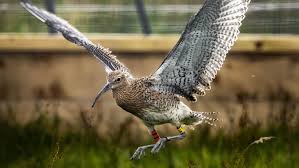Dartmoor’s rare curlews tracked to Portugal

Lisbon: Britain’s largest wading bird the Curlew. A brown bird in full flight with tracking tags on each leg with one red coloured the other yellow. The bird has a very long beak and is flying in a grassy area.
Some of the UK’s most endangered birds that have been reared and released on Dartmoor have been tracked to Portugal.
A number of curlew introduced to Devon this summer travelled the 1,300 miles (2,092km) to the Algarve.
“Several individuals travelled around the South West estuaries in Devon, Cornwall and the Isles of Scilly, however, this year some undertook an epic journey south, following the warmer weather,” said Jon Avon, curlew recovery project officer from the Duchy of Cornwall.

He said: “Three of the birds were located in northern Spain while two others made it all the way to the Algarve, in Portugal and southern Spain.”
The species is on the UK Birds of Conservation Concern Red List because of declining numbers.
The five-year project aiming to rekindle curlew numbers on the moor started in 2020 with eggs collected, artificially incubated and the young birds released.
In August, 25 young curlews were successful reared and released and a total of 107 have been introduced since the scheme began.
Some of the birds have been fitted with trackers, which captured their journey abroad for warmer weather.
Mr Avon said: “Two wild pairs also returned to Dartmoor, but their nesting attempts were unsuccessful this year.”
Eric Heath, senior project manager for species recovery at wetland restoration charity WWT, welcomed the news.
He said: “It’s wonderful to learn that some of our ‘headstarted curlew’ have been spotted soaking up the winter sun in Spain and Portugal, using the rich coastal wetlands in Iberia as a point of connectivity to the wider European curlew population.
“It’s still early days for this project, but we’re hopeful that Dartmoor’s curlew will once again flourish and will help to lead the way to a brighter future for curlew across the UK.”





